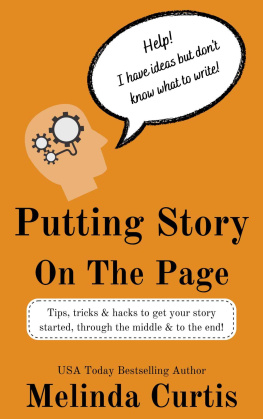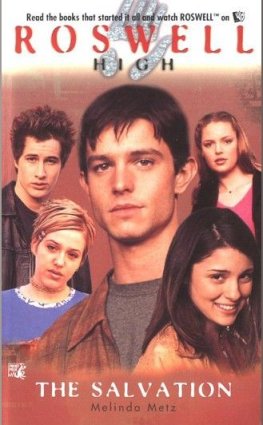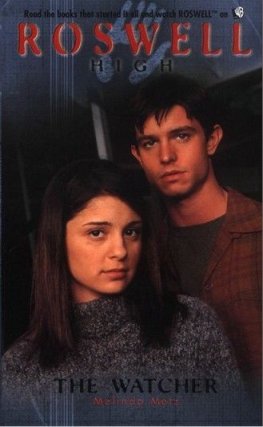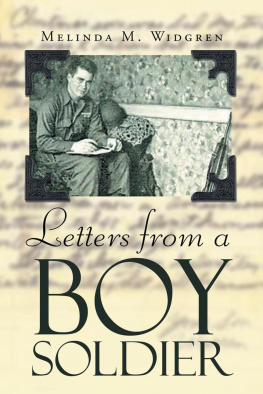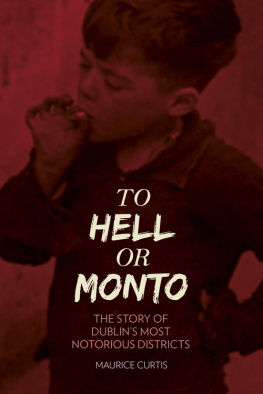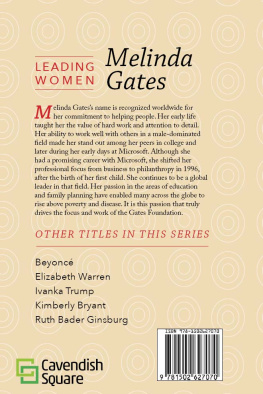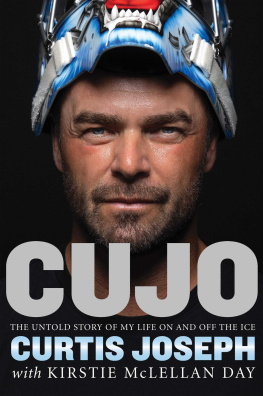Melinda Curtis - Putting Story on the Page
Here you can read online Melinda Curtis - Putting Story on the Page full text of the book (entire story) in english for free. Download pdf and epub, get meaning, cover and reviews about this ebook. year: 2022, publisher: easyepublish.com, genre: Romance novel. Description of the work, (preface) as well as reviews are available. Best literature library LitArk.com created for fans of good reading and offers a wide selection of genres:
Romance novel
Science fiction
Adventure
Detective
Science
History
Home and family
Prose
Art
Politics
Computer
Non-fiction
Religion
Business
Children
Humor
Choose a favorite category and find really read worthwhile books. Enjoy immersion in the world of imagination, feel the emotions of the characters or learn something new for yourself, make an fascinating discovery.
- Book:Putting Story on the Page
- Author:
- Publisher:easyepublish.com
- Genre:
- Year:2022
- Rating:4 / 5
- Favourites:Add to favourites
- Your mark:
- 80
- 1
- 2
- 3
- 4
- 5
Putting Story on the Page: summary, description and annotation
We offer to read an annotation, description, summary or preface (depends on what the author of the book "Putting Story on the Page" wrote himself). If you haven't found the necessary information about the book — write in the comments, we will try to find it.
Putting Story on the Page — read online for free the complete book (whole text) full work
Below is the text of the book, divided by pages. System saving the place of the last page read, allows you to conveniently read the book "Putting Story on the Page" online for free, without having to search again every time where you left off. Put a bookmark, and you can go to the page where you finished reading at any time.
Font size:
Interval:
Bookmark:
Putting Story on the Page
By
Melinda Curtis
Copyright (c)2022 by Melinda Curtis
All rights reserved. No part of this book may be reproduced in any form or by any means without the prior written consent of the Publisher, except for brief quotes used in reviews.
Dedication
This book is dedicated to Mr. Curtis, who has always been supportive of my writing, from the time I had this vulnerable idea in my head to my first experience hitting a bestseller list to visiting a movie set when one of my works was translated into film. Love you, Big Guy!
About the Author
Award-winning, USA Today Bestselling Author Melinda Curtis writes for Harlequin, Grand Central Forever and Caezik Romance as well as being independently published. After much exploration to find her author voice, she now writes mostly sweet romance and sweet romantic comedies. One of her booksDandelion Wisheswas made into a TV movieLove in Harmony Valley, starring Amber Marshall. Melinda has written over 70 books, including those on the craft of writingFrankly, my dearCreating Unforgettable Characters and Putting Story on the Page. In between writing deadlines, she can either be found helping her husband with home remodeling projects or teaching writing craft courses, in-person and online.
Foreword
Have you ever had an idea for a story and then opened up a notebook or an electronic file andnothing? Or have you ever written the first few chapters of a book or the first few pages of a script and thennothing? Or have you ever written the majority of a book or a script and been barreling toward the end whennothing?
If you answered YES to any of the questions above, this book is for you. Why? Because inside youll find user-friendly ways to jump-start story no matter where you find yourself. Ive been in all those confusing, cursor-blinking places. And when I say Ive been there, I mean Ive been through every one of those scenarios and then some. Ive tried various tips, tricks, and hacks to power through it and have experiences to share.
Ive sold and written more than 70 stories. Ive stared down looming deadlines with no word count. Ive been lost in the middle of books. And Ive gazed numbly at the blinking cursor wondering how Im going to make sense of what Ive written to produce a story that hangs together, much less provides a satisfying ending.
Im not proud to say that Ive wallowed and wasted time, sometimes justly so. A creative muse cant flit happily along when youre in the throes of grief or in the midst of family strife or wondering how to find a place to shelter after a devastating disaster. In those situations, give yourself some grace.
But if youre ready and in need of a way to move forward, help for your story has arrived! This book is the result of me studying creativity, psychology, and writing craft, fielding S.O.S. calls from writing friends, and teaching hundreds of eager writers how to put story on the page.
And story
Story comes in all shapes and sizes. Story can be as simple as Jack and Jill went up the hill to fetch a pail of water. Jack fell down. He cracked his head open. And then Jill fell down the hill after him. The End. Or story can be as long and complex as War and Peace or the entire Harry Potter series. But chances are that youre trying to write something in between the two.
Either way, when a great idea pops into your head, it most likely will not make an appearance on the page as a fully formed three-act story. There will be holes and blank pages. Possibly blinking cursors. Certainly, someone will ask you to describe your idea and expect an intelligent answer. All of which may be intimidating.
When your ideas dont start or finish themselves, you might get discouraged and doubt your choice of creative outlet or profession. Im here to tell you that YOU ARE A WRITER! YOU CAN DO IT!
Youre a writer from the moment a story idea pops into your head, and you decide to translate that idea into a written story or a script or a comic or a manga or a stand-up bit or a poem! You just have to believe in yourself and keep at it. This book is going to help you keep at it.
In these pages, youll find my method for putting story on the page. For great beginnings. For those hard to bear middles. For those ever-so-satisfying endings. Whats presented here is a method or a series of hacks, if you prefer, to keep your momentum moving forwarda pinch of this, a sprinkle of that, a whole lot of what works for this project and for you today. Because most writers knowand beginning writers will soon find outthat almost every story is different. Some are easy. Some are hard. Some want to lay there like unrisen bread dough. And some explode with an unnamed source of energy.
However your story presents itself, Ive got your back.
In the first part of this book, well explore plot and character development using examples from movies, TV, and my own work with the goal of applying these concepts to your latest project, no matter where you are in the process. And then well use those hacks and strategies to writeor keep writingyour story, from beginning to end. Thats right. The second part of this book explores what to draw from in your pre-work and when.
No matter where you are in your writing journey, youll find something to move yourself forward here.
So, what are you waiting for? Lets get started!
Happy writing!
Melinda Curtis
P.S. If youre looking for more in-depth insight into character, including character growth and character journey examples from over 100 movie/TV characters, try my book Frankly, my dearCreating Unforgettable Characters.
Part One
Your Story Idea
Introduction
What is story?
Before we deep dive into pushing your story forward, we need to understand the recipe for a good story. As with any good recipe, the chef puts their stamp on every dish, including and excluding the parts that please their palate. But regardless of what they include or leave out, every chef understands whats available in the kitchen. And so should you.
A good story recipe will have a combination of plot, character, world building, theme, story structure and genre considerations, plus your own brand of story magic. Some stories will be more plot heavy. Some will be more character-driven. What follows is an overview of each ingredient, which well explore with more practical applications in subsequent chapters. Each ingredient you include should inspire you to put words on your page.
Plot. What is plot? And what makes a good one? Well, plot is the answer to the question: What is your story about? And if you can reply with twenty words or less in a way that doesnt leave the questioner with glazed, bored eyes, so much the better! Plot is the engine that drives the story forward. A good plot will give you plenty to write about. In my mind, plot is external conflict. And external conflict is really just a story goal and respectable obstacles, ones that will take more than a conversation or a single scene to resolve.
Lets take a look at the story engine for Squid Game. In this Korean drama (Netflix), hundreds of financially strapped, desperate contestants compete for a chance to win millions of dollars. The catch? There can be only one winner and elimination means death. If this is your kind of storyor youre feeling especially creativejust reading those few lines outlining the story should give you ideas about what might happen. Thats the plot engine youre looking forone that drives ideas for the rest of the story. Yes, words for your page.
Character. What makes a good character? Certainly, one that is relatable, whether they are the hero, anti-hero, or the villain. Id argue you want at least one character readers or viewers will root for, which usually means you want them to have some sort of touchstone with your audience (redeeming quality, unusual skill, relatability, likability). And if youve created a character that your audience is interested in, youll want to make your audience worry about them. This is where Internal Conflict comes in.
Next pageFont size:
Interval:
Bookmark:
Similar books «Putting Story on the Page»
Look at similar books to Putting Story on the Page. We have selected literature similar in name and meaning in the hope of providing readers with more options to find new, interesting, not yet read works.
Discussion, reviews of the book Putting Story on the Page and just readers' own opinions. Leave your comments, write what you think about the work, its meaning or the main characters. Specify what exactly you liked and what you didn't like, and why you think so.

